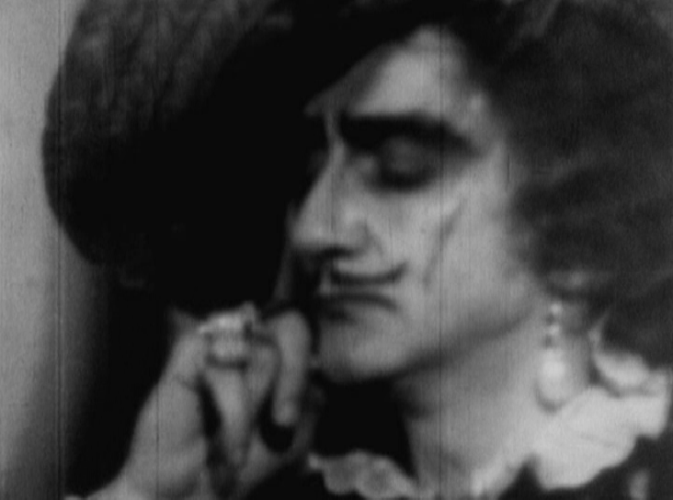I first heard of this
film under the title I’ve given this short essay. When I asked the author of
the book in which this reference appears what became of it, he informed me that
it was only its working title. It came to be known as No President.
Actually this is the
name Jack Smith gave to the character he asked Irving to play. I take it to be a
reference to Gene Kelly’s character, Serafin, in Vincente Minnelli’s The
Pirate, which was one of Jack’s favorite films (at least, according to one
list he left.)
The Pirate character in
No President bears an uncanny resemblance to Irving, and at one point
I believed that it was him behind this disguise, but I’ve read elsewhere that
the role was played by Doris Desmond, who also plays the woman wearing the
oversize gorilla pelt hood whose face is revealed from behind a skull mask.
From what I understand, regardless of their costume changes each player is only
intended to represent one character.
Perhaps, as in
Minnelli’s movie, where Gene Kelly is the itinerant Player pretending to be the
Pirate and Walter Slezak is the Pirate disguised as the banal, upstanding,
Mayor, these characters are intended as doppelgangers. The Pirate who kidnaps
the young Wendell and sells him on the auction block is the role the child
himself wishes to enact.
As the film is now, in
its forty five minute version, it consists of passages from a newsreel
documenting the Republican National Convention that nominated Wendell Willkie
to run against Roosevelt for the Presidency of the United States of America,
juxtaposed with Jack’s original material, representing an elaborate fantasy of
this same politician’s imaginary life.
The movie begins with
an excerpt from another documentary, a travelogue, showing handsome young
Sumatran fishermen going off to cast their nets. Besides their obvious function
as masturbatory fantasy material (for the young Smith, as well as this
fictional Wendell, trapped out in America’s heartland, one can imagine well
enough what these muscular guys in their wet loincloths could represent,) the
fishermen serve a metaphoric purpose, representing the artist and his comrades
casting their nets for the political prey.
There follows scenes
from the convention and a campaign stop by Willkie to a farm and some admiring
farm boys. The scenes that Jack shot show the infant Wendell surrounded by high
society dames in turn of the century drag and a sleepy nurse reading My
Book House: Through Fairy Halls by
Olive Beaupré Miller. One of the ladies shakes a very phallic looking rattle
in baby Wendell’s face as naked servants shake their cocks in the background.
There is another scene
that appears to refer to Delacroix’s Death of Sardanapalus where dead
or sleeping servants wiggle their cocks as baby Wendell fondles ears of native
corn. Another piece of found footage shows Dinah Shore and an unidentified male
singing in front of a fake down-home country farm house. Tally Brown
makes a forceful appearance, setting the scene as another reluctant slave put
up for sale, and some large handsome slaves in the background display the
strongest phalli so far seen.
Irving, as Willkie
clutching his designer satchel with prominent travel stickers, is finally
forced onto the auction block. The film ends with Wendell, sold, enveloped by
smoke as he is dragged down by unseen creatures, to the sounds of the
conventioneers cheering on their candidate. In terms of its social and art
historical reference points, No President contains some of the densest
images one is ever likely to see in a movie.





.jpg)

.jpg)
.jpg)
.jpg)


.jpg)
.jpg)

.jpg)



.jpg)
.jpg)



.jpg)

.jpg)

No comments:
Post a Comment